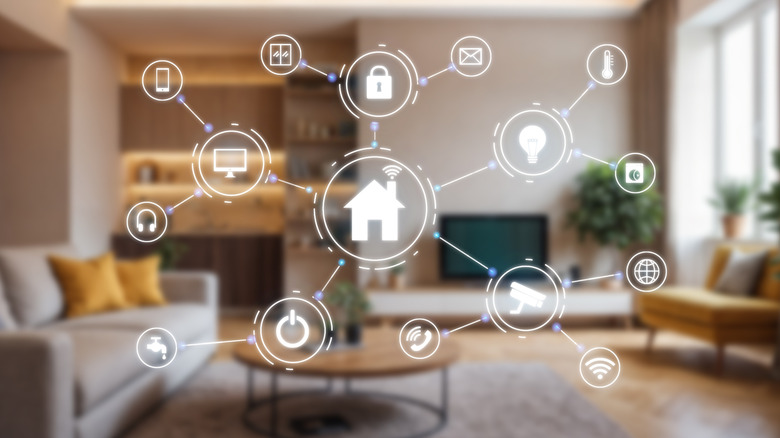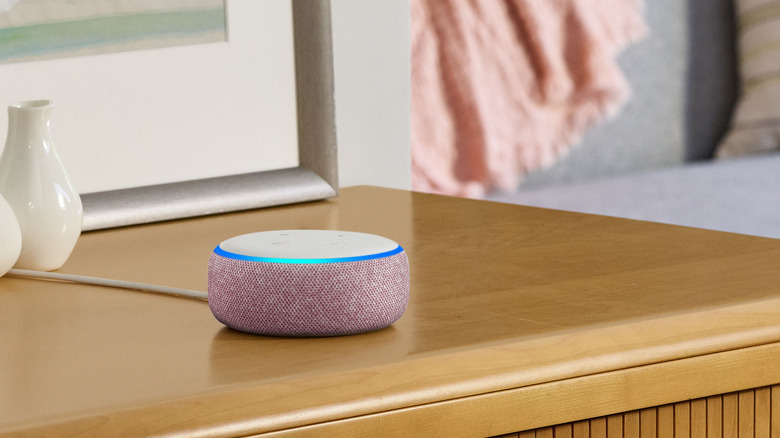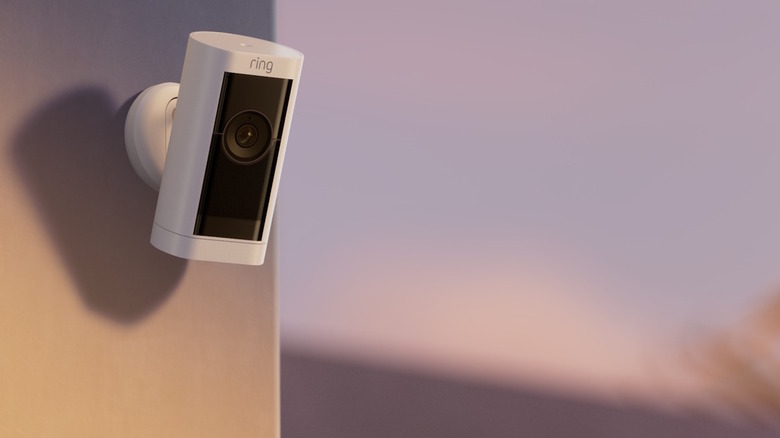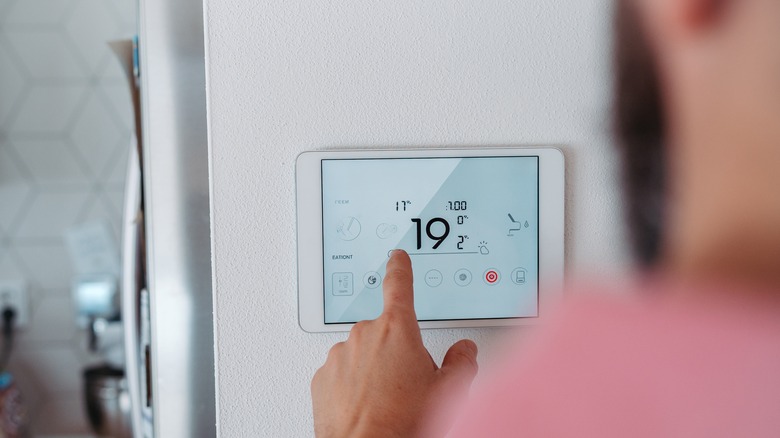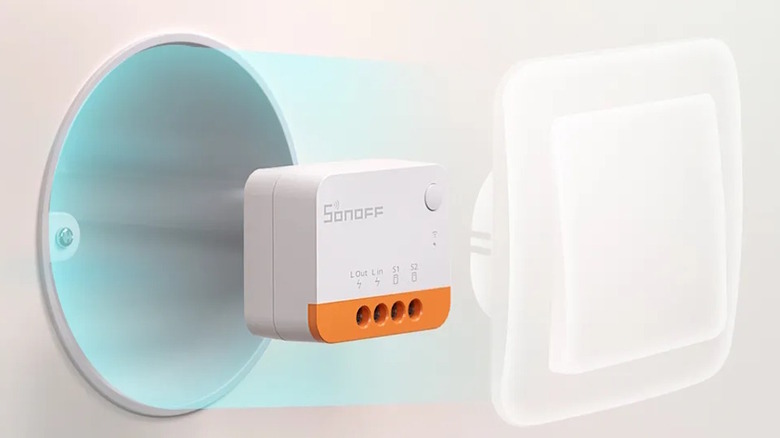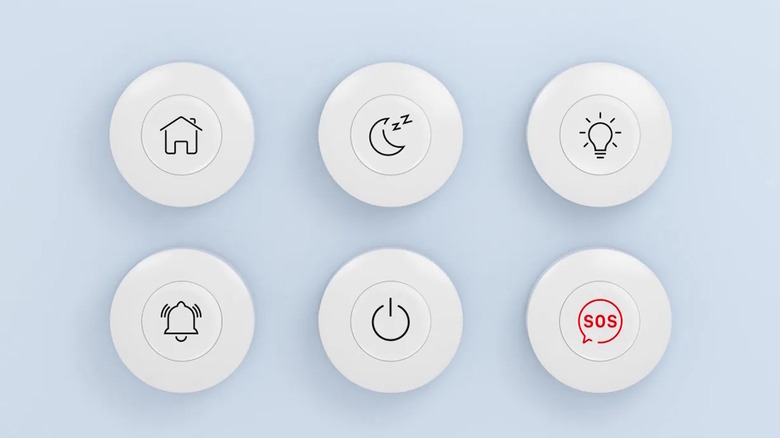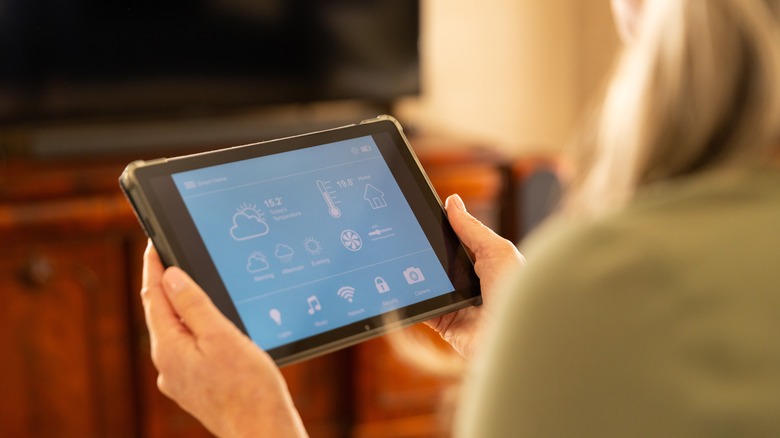6 Smart Ways To Automate Your Home That Won't Break The Bank
We may receive a commission on purchases made from links.
There is no single way to turn your house into a smart home, although there are a few essential steps. For instance, setting up a smart home hub and connecting it to at least some of your phones, screens, and speakers forms the backbone of any smart home set up. After all, the hub is the brain and the control devices are its eyes and ears. That would make the most customizable parts of this machine its muscles — the smart devices in the house now under the command of the hub.
Thankfully, there are plenty of devices to transform your smart home and make automation affordable, though even the simplest of them require time and effort to set up. Sometimes they take a while to get used to, as well.
Though the temptation may be strong, you shouldn't always go with what seems cheapest in the moment. Automatization is a kind of home improvement, and just like those it can be done for cheap, but it won't always stand the test of time. You don't want to build your smart light system on some off-brand smart light bulbs with proprietary control software that might no longer be in production five years from now, or clog your local network with dozens of smart devices that shouldn't have been using Wi-Fi in the first place. Replacing the devices you cheapened out on is harder and more expensive than going the more sensible route in the first place.
That's what the purpose of this article is — to help you choose carefully how and when to automate your home for cheap. Here are six smart home automations that you can implement without a huge initial investment.
Voice commands control the music while your hands are busy
Virtual assistant are nothing new, but if you haven't paid much attention to home automation, you might not have realized just how useful an ever-present vocal assistant can be. Getting your smart speaker to mute the music or skip to the next song when you have your hands full is invaluable, as anyone who has set up theirs in the kitchen knows. The best thing about it is that it's more or less free, assuming you already have a virtual assistant on your phone and a subscription to Spotify or one of its cheaper alternatives. Voice controlling the music on from a phone or a smart speaker is so simple that it barely counts as home automation, but we can push things further.
One of the most useful — but still basic — functionalities of a smart home system is a timer. Most virtual assistants, including Google Nest, Apple HomePod, and Amazon Dot, support timers for playing or stopping music. There's no limit to what those timers can do, and they aren't limited to music either. Some common uses include playing music at a low volume a few minutes before waking up, which makes getting out of bed in the morning a little easier. The same functionality can stop the music (or a podcast, or an audiobook) at a certain time, perhaps when you know you'll have already fallen asleep.
The same logic can be applied to countless other devices, including an old dumb TV you turned into a smart TV, which means that with a little creativity you can build a routine with technology you already have in your home.
Wireless security cameras let you check in on your house
Wireless smart cameras can have a variety of uses. Home safety is probably the first that comes to mind, but while they can certainly help protect your house, cameras are great for checking on pets or young children when you're not around. The temptation to place them outside your home is strong, but there are lots of mistakes that can be made when installing security cameras in certain locations, especially where they're exposed to the elements. You'll also need to make sure that its placement complies with local regulations. Yes, that includes the most popular front door smart camera-slash-video intercom, the Amazon Ring Doorbell Camera.
A strategically placed camera can also serve as a trigger for home automation. The simplest example being turning on the lights when someone walks in, but even this basic case use requires some effort and a pretty good smart camera, ideally one equipped with mid-distance night vision and event recognition, such as the Ubiquiti G5 Turret Ultra.
If the only thing you want out of your smart lights is turning on the front porch or entrance lights when someone passes by, a motion detector will probably serve you better and save quite a bit of money. However, if you have other reasons to want a camera in that room, or if you want the lights to stay on for as long as someone is in there, then a powerful smart camera is the way to go.
Automatic AC and heating maximize temperature control and minimize waste
Depending on how well insulated your house is, running the AC or a heat pump during off-peak hours can lead to more comfort and lower energy use. If your electricity bill is divided into peak and off-peak hours, you have a pretty big incentive to run anything you can during night hours. A small, quiet robot vacuum for small apartments shouldn't make too much of a ruckus and can be run while you sleep. The same goes for some dishwashers, washing machines and dryers. Still, while those are some of the heavy weights of domestic energy consumption, they don't hold a candle to heating and air conditioning.
In 2020, air conditioning alone contributed to almost 20% of American households power consumption. Most consumers don't use AC all year long, meaning that when they do use it, it eats up well above a quarter of the daily energy consumption. Heat pumps are usually much more efficient, both for heating and air conditioning, but their energy use is still significant when compared to something like an LED light. Most wouldn't want to waste a few cents keeping the lights on when it doesn't make sense to, so why do it with the much more expensive heating and cooling system?
A smart thermostat can keep your heat pump working at comfortable temperatures during the night and allow the climate to change slowly. Since keeping the temperature stable is easier than raising it, the pump doesn't have to work as much during the day — when electricity is more expensive — which should save you money.
Turn off the lights when you're not using them
Turning the lights on and off with a voice command instead of having to flip a switch is neat, but it's not exactly going to be life changing for most users. Making sure the lights are turned off once you're out of the house or when already in bed, on the other hand, saves you having to get up or go back in when you really don't want to, and perhaps don't even need to.
There are a number of smart gadgets to make sure the lights turn off when you're not using them. One solution requires either a smart camera or a motion sensor set up so that it turns the (smart) light switch off once it sees no movement. Ideally, you'll add a delay of a couple of minutes between the lack of movement and the lights turning off, lest you find yourself with a case of bathroom light too eager to turn itself off. Alternatively, you can set up a timer that turns off any light left on in the house at a certain time, when you know no one is using them.
Whether you rely on a camera or a virtual assistant, you'll have to switch out your old equipment for some smart switches or smart lightbulbs. Smart switches are usually the best choice, since they're far cheaper in the long run and they don't make the existing wall switch useless. Don't worry, you don't need to install new sockets. The Sonoff smart light switch that is compatible with the ZigBee Hub is relatively easy to install, even if it requires a bit of DIY.
Sometimes, you can't beat a switch
Some people take a bit longer to open up to promising new technologies. Unsurprisingly, those folks aren't too fond of ordering their phone around just to turn on the light. However, if you're going through the trouble of connecting all the lights in the house to your smart home hub to turn all of them on and off with a single word, you want everyone to have access to that power. That includes guests, who won't usually have access to your phone. With a physical smart mini switch, one button rules them all — the light switches, that is.
While they are called mini switches, they don't have anything to do with the actual smart wall switches, that come with the kits for transforming your light fixtures into smart devices. Mini switches are better understood as single-purpose remotes for your smart home, although some can be programmed to have a variety of functions and have multiple buttons.
As with most smart home devices, your choice of switch will be based on which kind of smart hub you already have. If you're managing your smart switches with ZigBee devices and a ZigBee hub, the Zigbee Switch is your best choice.
Repurpose an old tablet into a cheap smart display
Turning an old tablet into a smart display might seem like an involved DIY project, but in reality it barely requires any work. After all, plenty of cheap tablet are better than you think. It's almost certainly more powerful than the Google Nest Hub and the cheaper options in Amazon's Echo Show line, and it probably has a larger screen as well.
The only downsides as far as hardware is concerned are the lack of a built-in stand and slightly worse sound quality, which is nothing that can't be fixed with some budget-friendly tablet accessories. What makes the choice of tablet a little harder is the dedicated smart home hub OS that smart displays and speakers come with, which can be harder to replace.
Some tablets can't freely connect to the popular smart home ecosystems offered by the Google, Apple, or Amazon. In that case, you might consider using Samsung's SmartThings, which is more widely supported by interfaces like phones and tablets. Another option is the open-source project Home Assistant, but while you can use any old tablet as a control surface for them, it won't replace a smart home hub. Ultimately, whether an old tablet is for you depends on which smart home hubs you have and whether you're looking for a hub or just a control screen.
